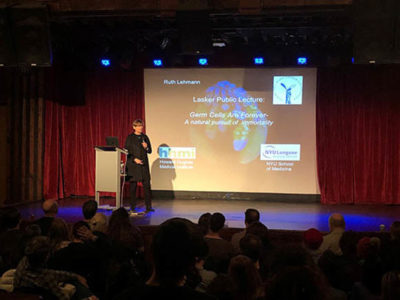On November 19, Ruth Lehmann, Director of the Skirball Institute of Biomolecular Medicine at New York University, entered a bar and walked to the front of the room. She turned to face a standing room only crowd and began to speak. “I felt a little bit like an onstage comedian trying to engage my audience,” she said.

Ruth Lehmann presenting at the Bell House in Brooklyn, NY
More accustomed to presenting in scientific meetings and classrooms, Lehmann embarked on a new experience in science communication when she accepted an invitation from the Secret Science Club (SSC) and the Lasker Foundation. She agreed to present her research for the Lasker Public Lecture in honor of Al Sommer at the Bell House in Brooklyn, NY. “I want to be an approachable scientist. I think it is very important for scientists to learn how to communicate,” she said. “I strongly believe that events like this dispel the idea of the reclusive, un-understandable, arrogant scientist.”
Bringing scientists directly to the public to speak and answer questions is a primary goal of the SSC, according to co-founder Dorian Devins, who emphasized that science is a part of daily life, not simply a course to take. The SSC launched in 2006 when Devins and Margaret Mittelbach accepted responsibility for organizing some events at a small performance space beneath the Union Hall bar in Brooklyn. With their backgrounds in journalism and radio and a shared fascination with science, they wondered if they could create a fun, informal science lecture series in a social atmosphere. “The venue primarily hosted bands and comedy, and we were intentionally putting a monthly night of science into that mix. Would people show up? It was an experiment,” Mittelbach recalled.
To keep things light and low-key, they scheduled themed cocktails and live music to coordinate with the scientific topic of the night, and then worked overtime spreading the word. And they offered admission free of charge—a tradition they continue today. Their efforts paid off. From the beginning, the events filled to capacity with enthusiastic audiences ready to engage. By 2009, they had outgrown their venue and were turning people away, prompting a move to the Bell House, which can hold up to 400 people.
While the SSC anticipated this same large and eager audience to attend Lehmann’s talk, “I was worried that no one would show up and no one would ask questions,” Lehmann said.
Lehmann studies germ cells—the cells that form eggs and sperm—using a fruit fly model. But she expected that people at the Bell House might be more interested in learning about human cells. So with her audience in mind, she explained why germ cells are unique and fascinating—and essential to human life. “The room was packed, and I got really good questions,” she said. “Some of the questions wandered a bit further to medical and societal questions and I answered them honestly and stated my opinion.”
According to the SSC leaders, many of the regular audience members have strong lifetime interests in science, but their team works hard to attract new people who aren’t sure how interested they are or who might view science negatively. The question and answer sessions and one-on-one conversations with presenters personalize the topics, helping audience members see how scientific discovery affects their individual lives and health, and maybe even sparking new curiosity. “I hope to do more such presentations,” Lehmann said. “It gave me a good feeling about being a scientist.”
